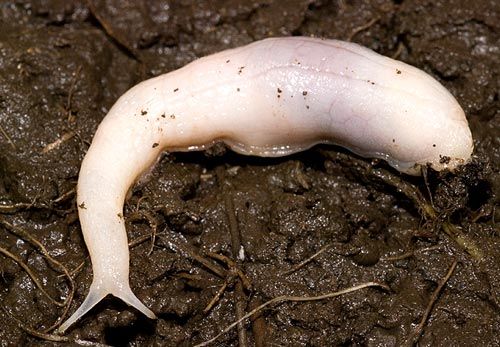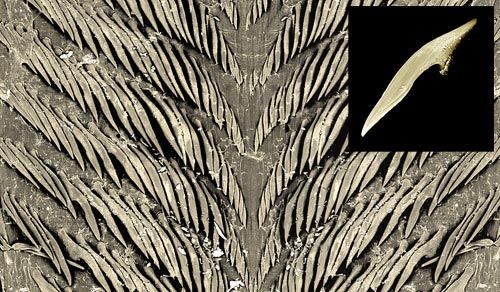Press Releases
'Ghost slug' is a mystery - New species of slug surfaces in the UK
Date:
2008-07-10British gardeners may encounter an unexpected arrival this summer – the bizarre subterranean Ghost Slug or Selenochlamys ysbryda, as named by experts at National Museum Cardiff, Wales.
Noticed in a Cardiff garden in 2007 by a member of the public, biologists at National Museum Cardiff and Cardiff University were amazed when shown specimens, which has never been seen before in Europe. The Ghost Slug has also been spotted in a garden in Caerphilly, South Wales.
This type of creature is usually found in Turkey and Georgia, but the origin of this particular slug and how it got to Britain is unknown. Unlike most slugs, the Ghost Slug is carnivorous and kills earthworms at night with powerful, blade-like teeth, sucking them in like spaghetti. It has no eyes, is completely white, and lives underground, squeezing its flexible body into cracks to get at the worms.

An adult Ghost Slug, about 7cms long.
"The Ghost Slug belongs to an obscure and almost unpronounceable group of slugs - the Trigonochlamydidae," said Ben Rowson, a biologist at National Museum Cardiff. "We had to thumb through lots of old publications in Russian and German to find anything like them - but then discovered they were something entirely new."
Unlike others from the group of creatures which are larger, have no eyes and a different internal anatomy, the scientists realised it was an undescribed species that had no scientific name. They decided to name the creature Selenochlamys ysbryda, partly from the Welsh word ysbryd meaning ghost, a name which appears with the species' description in June's edition of the Journal of Conchology. Ben explained:
"Selenochlamys ysbryda seemed appropriate for this spooky, nocturnal hunter and indicates where it was first found. We think this is the first time a Welsh word has been used in an animal's scientific name."
Bill Symondson, an ecologist at Cardiff University also studied the slug. He added:
"The lack of eyes and body colour could indicate the species evolved in a cave system. It was probably introduced to Britain in plant pots, making it an 'alien' species, although we can't be certain. We're concerned that it might become a pest, but we need to find out more about it first."
To monitor the Ghost Slug's spread, the Museum have produced a simple identification guide available from their website: www.museumwales.ac.uk/en/rhagor/article/?article_id=193.
Museums with natural history collections and staff such as National Museum Cardiff are often the best place to identify unusual animals or plants, and most welcome enquiries from the public.
Admission to Amgueddfa Cymru is free thanks to the support of the Welsh Assembly Government.
Amgueddfa Cymru operates seven national museums across Wales. These are National Museum Cardiff, St Fagans: National History Museum, National Roman Legion Museum, Caerleon, Big Pit: National Coal Museum, Blaenafon, National Wool Museum, Dre-fach Felindre, National Slate Museum, Llanberis and the National Waterfront Museum, Swansea.
For further information, please contact Catrin Mears, Communications Officer, National Museum Cardiff on 029 2057 3185 / 07920 027067 or email catrin.mears@museumwales.ac.uk.
Notes to editors:
- A scientific description of the species was published this month in the Journal of Conchology (a British zoological journal dedicated to molluscs, established 1874) (Journal of Conchology - volume 39 - page 537 - 552).
- Cardiff University:
Cardiff University is recognised in independent government assessments as one of Britain's leading teaching and research universities. It is also ranked as one of the world's top 100 universities by the Times Higher Education Supplement (THES). 2008 marks the 125th anniversary of Cardiff University having been founded by Royal Charter in 1883. Today the University combines impressive modern facilities and a dynamic approach to teaching and research. The University's breadth of expertise in research and research-led teaching encompasses: the humanities; the natural, physical, health, life and social sciences; engineering and technology; preparation for a wide range of professions; and a longstanding commitment to lifelong learning. Cardiff is a member of the Russell Group of the UK's leading research universities and was rated 7th in the UK for the quality of its research. Visit the University website at: www.cardiff.ac.uk.
- Online resources:
Ghost Slug ID guide:
www.museumwales.ac.uk/en/rhagor/article/?article_id=193
Bill Symondson's slug page [Cardiff University]:
http://www.cf.ac.uk/biosi/staffinfo/wocs2.html
